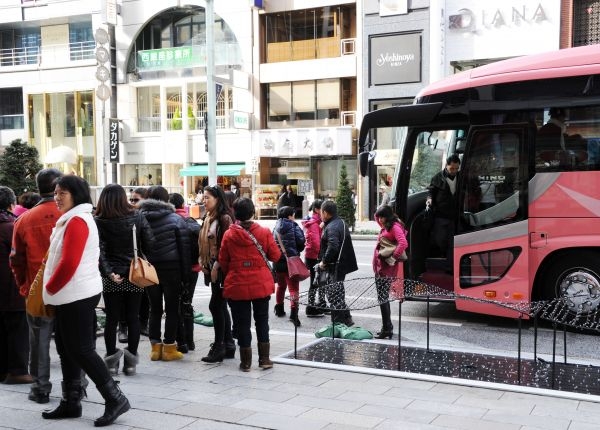SHANGHAI, Sept 3 — China’s biggest online travel agency is offering a 30 per cent discount on trips to Southeast Asia’s beaches and malls. The Chinese aren’t buying it.
“Singapore, Malaysia and Thailand are traditionally the favorite tourism route for the Chinese,” said Jiang Haibin, a public affairs manager at Ctrip.com International Ltd. “This year, that route was affected a lot.”
Chinese travelers have been deterred by political violence and the mysterious disappearance almost six months ago of a Malaysia Airlines plane bound for Beijing.
Territorial skirmishes with the Philippines and Vietnam have also hurt inter-government relations, while Singapore, a transit hub and stopover for those traveling around in the region, said China arrivals dropped 30 per cent in the first six months of the year.
Visitors from China made up a 10th of all arrivals to the region in 2012, threatening an industry that employs millions in Southeast Asia and contributes billions of dollars to the region’s gross domestic product. Chinese travelers have been the fastest-growing tourism market for the 10-member Association of Southeast Asian Nations, accounting for the majority of the increase over the past decade, according to Chua Hak Bin, an economist at Bank of America Merrill Lynch.
The Philippines has seen visitor growth from China slow amid disputes between the two countries in the South China Sea. That was even before authorities in the Southeast Asian nation announced yesterday a plot by a group called the USAFFE to strafe Chinese-linked establishments including the nation’s embassy in the capital Manila.
Economic ties
The economic relationship between China and Southeast Asia has spanned centuries and extends beyond tourism to trade and investment. China was the largest trading partner of Asean last year, with the bloc importing more from the region’s No. 1 economy than it exported to it.
For Malaysia, the impact of the March 8 disappearance of Flight 370 has been compounded by the kidnapping of Chinese nationals visiting and working in the country. Malaysia’s tourist arrivals from China dropped 32 per cent in May from a year earlier, after a 20 per cent decline in April.
About two-thirds of those on board the Malaysian Airline System Bhd. jetliner that vanished were from China, sparking street protests in Beijing and boycotts by travel agencies.
Bookings from China dropped 50 per cent to 60 per cent after the loss of MH370, Malaysia Airlines’ director of commercial operations Hugh Dunleavy said in May. In July, another one of its planes was shot down over Ukraine.
Power Shift
Thailand attracted 342,547 visitors from China in July, a 25 per cent drop from the same period a year earlier, according to data from the Ministry of Tourism and Sports. Travelers from China accounted for 18 per cent of total visitors to Thailand that month, compared with 21 per cent a year earlier.
The decline in visitors since the army seized power in a May 22 coup has been more severe in the capital Bangkok. In the seven months ended July, the number of travelers from China visiting Bangkok fell 35 per cent, compared with a 21 per cent drop nationwide.
“The MAS air disasters and Thailand’s military coup are probably temporary factors that will dissipate over time,” said Chua of Bank of America in Singapore. “Longer-term, Asean tourism remains bright despite recent setbacks, boosted by affordable air travel, increasing connectivity, a growing middle class, and a rising and more affluent China.”
Japan’s Gain
For now, Southeast Asia’s loss is Japan’s gain. Visitors from China doubled in July from a year earlier, and more are heading to Australia, the US and Italy, tourism data show.
Thailand’s hotel revenue per available room fell 15 per cent in July, while Malaysia’s declined 11 per cent, according to Bloomberg Intelligence, citing Smith Travel Research. In contrast, Osaka’s hotel revenue per available room jumped 20 per cent in the same period, while Tokyo’s climbed 9 per cent.
Ties between China and fellow communist nation Vietnam cooled after a Chinese oil rig was placed off Vietnam’s coast in May. It led to deadly anti-Chinese riots in Vietnam where protesters damaged factories and halted production lines.
Chinese visitors accounted for more than a fifth of Vietnam’s foreign arrivals in July, even as their numbers dropped by 29 per cent compared with a year earlier, according to the General Statistics Office in Hanoi.
Bali Beaches
Indonesia may be an exception. There’s no sign of a downturn there, where the beaches and culture of Bali island are the most popular draw. The number of Chinese tourists visiting the world’s largest archipelago rose 22 per cent in the first six months of 2014, with a spike in arrivals during the Lunar New Year holiday in January and February, according to the country’s statistics office.
The Indonesian government is promoting tourism in China and has started a Chinese-language website with the aim of lifting arrivals by 37 per cent to one million by the end of 2014, Antara news agency reported.
A turnaround for more countries in the region including Thailand may come only next quarter, said Daphne Roth, head of Asian equity research at ABN Amro Private Banking in Singapore. In August, Thailand waived visa fees for visitors from China and Taiwan for 3 months to boost tourism.
The establishment of the Thai cabinet earlier this week will “pave the way for the lifting of martial law imposed right now, which will draw tourist numbers again,” Roth said. — Bloomberg



















